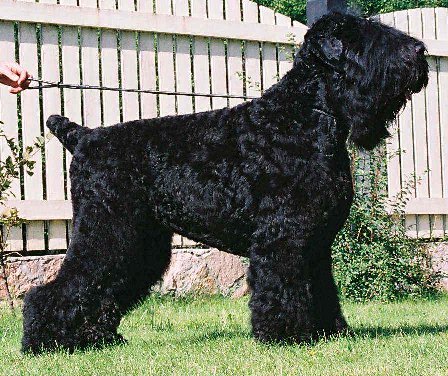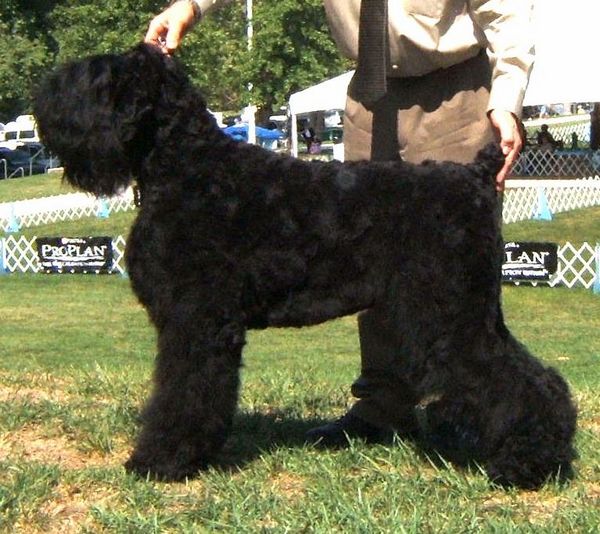
The Breed History
Following WW II, a kennel in the Soviet Union worked to develop
a hardy working dog from resident breeds of the time. The 1950s
saw serious breed development using 17 breeds in the initial
breeding pool, including Rottweilers, Giant Schnauzers, Airedale,
Moscow Diver, Newfoundland and Caucasian Ovcharka dogs.
The first breeding crossed Roy, a Giant Schnauzer with a female
Rottweiler. By 1981 they were granted official breed status. Of the
two subtypes, the more massive constitution is preferred over the
terrier type, so much so that the breed was moved from terrier to
working breed.
Breeding for Function
These dogs were bred to work as guard dogs and protection dogs.
The breeders wished to develop a dog that required minimal coat
care, was a large size with exceptional strength and excellent
trainability and high but controlled aggression. Early in breed
development, appearance was sacrificed for good working ability,
and heterogeneous appearance was typical. Two subtypes emerged.
The first, a terrier type and the second a more massive "bear" dog
with coarse build.
Physical Characteristics
Height at Withers: female 26-29" (66-74 cm), male 27-30" (69-76
cm); disqualified if under 26" (66 cm).
Weight: 77-120 lb (32-54 kg).
Coat: Color must be black, or black intermixed with a few other
gray hairs. A thick double coat, with a coarse overcoat and
undercoat thick and soft in texture. Length of hairs 1.5-4" (4-10
cm) and has a tousled appearance-not wiry, not curly. Hair in and
around the ears is trimmed for show. Fairly easy keeping coat.
Longevity: 10-14 years
Points of Conformation: Robust, this heavily boned dog is well
muscled and capable of great endurance. Bitches are more refined,
but still strongly built. Only very slightly longer than tall, they
give an overall impression of great strength. The skull is broad
and strong, with a blocky appearance with moderate stop. A
prominent occipital protuberance is characteristic. Nose is large,
black. The eyes are oval, medium in size and darkly pigmented.
The palpebral margins are tight and black, as are the lips. No
flews. Small triangular ears are high set, and just reach the lateral
canthus. Gingival surface is pigmented, and spots of pigment may
occur on the tongue. Neck thick, well muscled, the thorax is wide
and deep with oval cross section, pronounced withers merge with
level topline. The abdomen is well tucked up, loin is short. Limbs
are straight, with very short straight metacarpals/metatarsals, and
large rounded feet. Nails dark and rear dewclaws often removed.
The thick tail is high set, and usually docked to the length of 3-5
vertebrae. Gait is springy, smooth and long.
Recognized Behavior Issues and Traits
Breed attributes ascribed include: Excellent protection instinct,
reliable, courageous, calm, intelligent, with high trainability. They
are stubborn when it comes to retraining though, as they seem to
have very long memories. May be somewhat aloof with strangers.
The terrier subtype is somewhat high strung, while the massive type
is much more settled, even tranquil when not working.
Normal Breed Variations
None reported
Drug Sensitivities
None reported
Inherited Diseases
Hip Dysplasia: Polygenically inherited trait causing degenerative
joint disease and hip arthritis. OFA reports 43.0% affected.
Elbow Dysplasia: Polygenically inherited trait causing elbow
arthritis. OFA reports 30.2% affected.
Hyperuricosuria/Urate Urolithiasis (Bladder Stones): Autosomal
recessive disorder of urate metabolism due to a mutation in the
SLC2A9 gene. Urate bladder stone formation is secondary to
hyperuricosuria. Affected dogs require lifelong diet and medication
to prevent reoccurrence. A genetic test is available.
Patella Luxation: Polygenically inherited laxity of patellar
ligaments, causing luxation, lameness, and later degenerative
joint disease. Treat surgically if causing clinical signs. Too few
Black Russian Terriers have been screened by OFA to determine an
accurate frequency.
Disease Predispositions
Hypothyroidism: Inherited autoimmune thyroiditis. Identified in
the breed, however too few Black Russian Terriers have been thyroid
tested at Michigan State University to determine an accurate
frequency. (Ave. for all breeds is 7.5%). OFA reports 2.6% of 38
dogs tested were affected. This number may change as more Black
Russian Terriers are tested.
Progressive Retinal Atrophy (PRA): Inherited degeneration of
the retina, progressing to blindness. Onset 6 months to as late
as 42 months of age. Black Russian Terriers with PRA go blind
gradually, first losing their night vision and then their day vision.
Many do not go completely blind until they are 8 years old or older.
Undetermined mode of inheritance.
Subaortic Stenosis and Mitral Valve Dysplasia: Identified in
three 2 month old Black Russian Terrier littermates. In other breeds,
subaortic stenosis is inherited as a polygenic trait.
Other Ocular Disorders: Too few Black Russian Terriers have been
CERF examined to determine accurate breed frequencies for ocular
disorders.
Isolated Case Studies
Extra Molars (Compound Odontomas): A six month-old, male
Black Russian terrier dog was presented for oral masses on both
sides of the mandible lateral to the first molars, which radiographs
revealed to be small teeth (denticles). Treatment consisted of
extraction of all denticles.
Congenital Cataract and Microphthalmia: Case study of a
litter of Black Russian Terriers born with congenital cataracts and
microphthalmia.
Genetic Tests
Tests of Genotype: Direct test for hyperuricosuria is available from
the UC-Davis VGL and Animal Health Trust.
Tests of Phenotype: CHIC Certification: Required testing
includes hip and elbow radiographs, CERF eye examination, and
cardiac evaluation by a cardiologist. Recommend thyroid profile including autoantibodies, and patella
evaluation.
Miscellaneous
- Breed name synonyms: Black Terrier, Chornyi, Terrier Noir Russe,
Russian Bear Schnauzer, Tchiorny Terrier
- Registries: AKC, CKC, FCI, SKC, ANKC (Australian National Kennel
Club), NKC (National Kennel Club)
- AKC rank (year 2008): 121 (245 dogs registered)
- Breed resources: Black Russian Terrier Club of America:
www.brtca.org
Black Russian Terrier Club of Canada: www.brtcc.ca
Black Russian Terrier Club (UK): www.rbtclub.co.uk
Photo Gallery of Breed - Black Russian Terrier - Dog Breed








 Animalia Life
Animalia Life